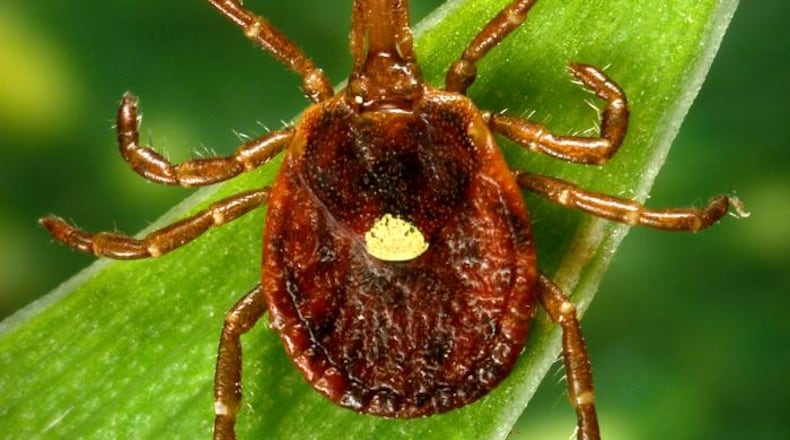For many, the arrival of warmer weather means a return to hiking trails, state parks and nature reserves.
But Georgians eager to strap on their hiking boots should take steps to protect themselves against ticks and the health problems they can cause. That’s especially true for hikers around metro Atlanta, a region with a likely outsized concentration of lone star ticks, according to a newly published study by a team of Emory University researchers. A wily biter of humans, the lone star tick can spread a slew of pathogens, and even trigger a potentially deadly allergy to red meat and dairy products, known as alpha-gal syndrome.
Published in the journal Parasites & Vectors, the Emory study sought to map the distribution of the lone star tick across the state. Aside from metro Atlanta, the areas with the highest probability for the presence of lone star ticks include the southern and middle portions of Georgia.
“We found that these regions contain sweet spots for the lone star tick,” said Stephanie Bellman, first author of the study and an MD/PhD student in Emory’s School of Medicine and Rollins School of Public Health, in a statement. “They tend to be more prevalent in forested areas of mid-elevation – not too high or too low – and in soils that retain moisture but are not swampy.”
Credit: Courtesy of Emory University
Credit: Courtesy of Emory University
Bigger temperature swings in the northern and more elevated part of the state – and along Georgia’s coast – make those regions less amenable to the lone star tick.
Researchers were able to map the tick’s likely distribution by combining field data with other research techniques. Outings to collect tick samples prioritized state parks and wildlife management areas, places that host recreational activities such as hunting or hiking.
“Those are the more likely points of exposure for humans,” said Gonzalo Vazquez-Prokopec, a professor in Emory’s Department of Environmental Sciences and senior author of the study.
Vazquez-Prokopec hopes the team’s map will be used to target areas for tick-bite prevention messaging.
“It’s an educational tool for the public,” he said.
Tick-bite prevention is perhaps more relevant than ever.
In the past two decades, the annual number of tickborne illnesses in the U.S. has more than doubled. A report released last year by the Centers for Disease Control and Prevention estimates that as many as 450,000 Americans may have developed alpha-gal syndrome.
The surging prevalence of tickborne diseases is tied to many tick species’ expanding geographic ranges, a phenomenon tied to warming temperatures induced by climate change. Vazquez-Prokopec explained that land-use change also plays a role, with the outward spread of residential development blurring the lines between urban and rural.
“Ticks have more opportunities to find the hosts that they need,” he said. Aside from alpha-gal syndrome, a bite from a lone star tick can also transmit ehrlichiosis, southern tick-associated rash illness (STARI), and Heartland virus disease.
An ‘aggressive’ tick
In their paper, the team of Emory researchers described the lone star tick as “aggressive.”
“They really are very good at grabbing onto hosts, particularly humans, and staying with them,” Vazquez-Prokopec said. “When you go the forest [and step] outside a path or trail, it’s one of those ticks that is basically waiting for you on the tip of branches, different types of vegetation. As soon as you touch that vegetation, they’re going to latch and grab onto your clothes and then climb onto your body.”
Native to the Southeastern U.S., the lone star tick is the most common tick found on humans in Georgia.
Alpha-gal syndrome is caused by a sugar, alpha-gal, that is present in both meat from mammals and in the saliva of lone star ticks. It’s a molecule injected by the tick onto its host when feeding, and it triggers an immune response that can then lead to potentially fatal severe allergic reactions when meat is consumed. Alpha-gal syndrome is a long-lasting condition.
CDC recommendations to prevent tick bites include using repellent and walking in the center of trails when hiking. After coming in from the outdoors, it’s important to inspect your clothing, pets, and body for ticks, and take a shower.
Vazquez-Prokopec recommends people check themselves as soon as they get back in their cars after being outside. That’s because some pathogens can be transmitted from a tick bite in a manner of minutes. Ticks are also easier to remove shortly after they latch themselves onto a host.
“The longer you wait, the harder it is to remove them.”
If you find a tick attached to your skin, the CDC recommends removing it using a pair of clean, fine-tipped tweezers. Pull the tick upwards with steady, even pressure and thoroughly clean the bite area.
The Atlanta Journal-Constitution and Report for America are partnering to add more journalists to cover topics important to our community. Please help us fund this important work here.
About the Author
Keep Reading
The Latest
Featured




